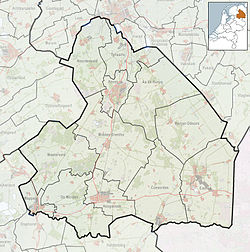Nieuwlande | |
|---|---|
 Street in Nieuwlande | |
| Coordinates: 52°41′45″N6°36′43″E / 52.69583°N 6.61194°E | |
| Country | Netherlands |
| Province | Drenthe |
| Municipality | Coevorden, Hoogeveen, some houses in Hardenberg |
| Population (1 January 2023) | |
• Total | 1,419 |
| Major roads | A37 |
| Righteous Among the Nations |
|---|
 |
| By country |
Nieuwlande (Dutch Low Saxon: Neilaande) is a Dutch village located in the north-eastern province of Drenthe situated in the municipality of Hoogeveen. The population, as of 2023 is 1419. [1] Nieuwlande is one of only two villages in the world that collectively received the Righteous Among the Nations award for its Holocaust Rescue story where nearly all of the town's residents hid and saved the lives of hundreds of Jews as well as resistance fighters and German deserters during World War II. [2]
Contents
Nieuwlande is on peatland in the south of Drenthe. It arose where five municipalities meet: Oosterhesselen (by far the largest part), Dalen, Coevorden, Hardenberg, and Hoogeveen. For this reason, a book about Nieuwlande's history had the catching title "Nieuwlande, village with five burgomasters". This situation obstructed to a great extent the extension possibilities and an efficient governing board: for many municipalities it was but an unimportant peripheral area. Therefore, at the municipal division of Drenthe on 1 January 1998 it was decided for the village to be in one municipality, by moving over to the municipality border of Hoogeveen about 1.5 kilometres to the east. The small part of the municipality of Hardenberg (province Overijssel) was, however, not affected by this; and also beyond the new municipality border some inhabitants of Nieuwlande still lived in the new fusion municipality Coevorden. The border now, however, no longer goes straight through the village.
Nieuwlande has a new Dutch Reformed church, a Reformed church from 1913, and a church of the meeting of the believers. It also has sports fields; a public and Protestant primary school; a hypermarket with a mail agency; children's playgrounds under its jurisdiction, other companies, and public places. Rural areas are characterised by agriculture (peat diggings) and some nature reserves - scrub and heathland or peat.


